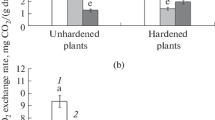Abstract
We have identified two types of invertases, one bound ionically and the other covalently to the particulate fraction in grains of heat tolerant C 306 and heat susceptible WH 542 cultivars of wheat (Triticum aestivum L.). The cell walls contained a high level of invertase activity, of which 79.2–72.8% was extractable by 2 M NaCl and 14.9–21.1% by 0.5% EDTA in C 306 and WH 542, respectively. The NaCl-released invertase constituted the predominant fraction. Using 5–100 mM sucrose and pH range of 4.0–7.0, the apparent Michaelis constant (K m, enzyme substrate affinity measure) of enzyme ranged from 5.73 to 16.06 mM for C 306 and from 6.08 to 19.86 mM for WH 542. The V max (maximum catalytic rate) values at these pH were higher in C 306 (0.63–11.04 μg sucrose hydrolysed min−1) than WH 542 (0.51–8.73 μg sucrose hydrolysed min−1). By employing photo-oxidation and by studying the effect of pH on K m and V max, the involvement of histidine and α-carboxyl groups at the active site of the enzyme was indicated. The two cultivars also showed differential response in terms of thermodynamic properties of the enzyme i.e. energy of activation (E a), enthalpy change (ΔH) and entropy change (ΔS). NaCl-released invertase showed differential response to metal ions in two cultivars suggesting their distinctive nature. Mn2+, Cu2+, Hg2+, Mg2+, Zn2+ and Cd2+ were strong inhibitors in WH 542 as compared to C 306 while K+, Ca2+ were stimulators in both the cultivars. Overall the results suggest that genetic differences exist in wall bound invertase properties of wheat grains as evident in its altered kinetic behaviour.


Similar content being viewed by others
Abbreviations
- EDTA:
-
Ethylenediamine-tetraacetic acid
- E a :
-
Energy of activation
- ΔH :
-
Enthalpy change
- ΔS :
-
Entropy change
- ∆G :
-
Free energy change
References
Asthir B, Kaur A, Basra AS (1998) Kinetic behaviour of soluble invertases may be connected with differential heat sensitivity of two wheat genotypes. Acta Physiol Plant 20:285–289
Cheikh N, Jones RJ (1995) Heat stress effects on sink activity of developing maize kernels grown in vitro. Physiol Plant 95:59–66
Dickinson CD, Altabella T, Chrispeel M (1991) Slow-growth phenotype of transgenic tomato expressing apoplastic invertase. Plant Physiol 95:420–425
Dixon M (1953) The effect of pH on the affinity of enzymes for substrates and inhibitors. Biochem J 55:161–171
Dixon M, Webb EC (1964) Enzymes, 2nd edn. Longman, Green, London, pp 84–87
Elmore DT, Kingston AE, Shields DB (1963) The computation of velocities and kinetic constants of reactions, with particular reference to enzyme-catalyzed processes. J Chem Soc 13:2070–2078
Goetz M, Godt DE, Guivarch A, Kahmann U, Chriqui D, Roitsch T (2001) Induction of male sterility in plants by metabolic engineering of the carbohydrate supply. Proc Natl Acad Sci 98:6522–6527
Huang LF, Bocock PN, Davis JM, Koch KE (2007) Regulation of invertase a ‘suite’ of transcriptional and post-transcriptional mechanisms. Funct Plant Biol 34:499–507
Hussain A, Rashid MH, Perveen R, Ashraf M (2009) Purification kinetic and thermodynamic characterization of soluble acid invertase from sugarcane (Saccharum officinarum L.). Plant Physiol Biochem 47:188–194
Karuppiah N, Vadlamudi B, Kaufman PB (1989) Purification and characterization of soluble (cytosolic) and bound (cell wall) isoforms of invertase in barley (Hordeum vulgare) elongating stem tissue. Plant Physiol 91:993–998
Klotz KL, Finger FL (2001) Activity and stability of a soluble acid invertase from sugarbeet roots. J Sugar Beet Res 38:121–137
Kocal N, Sonnewald U, Sonnewald S (2008) Cell wall-bound invertase limits sucrose export and is involved in symptom development and inhibition of photosynthesis during compatible interaction between tomato and Xanthomonas campestris pv vesicatoria. Plant Physiol 148:1523–1536
Krishnan HB, Blanchette JT, Okita TW (1985) Wheat invertases. Characterization of cell wall bound and soluble forms. Plant Physiol 78:241–245
Lineweaver H, Burk D (1934) The determination of enzyme dissociation constants. J Amer Chem Soc 56:658–666
Masuda H, Sugawara S (1980) Purification and some properties of cell wall-bound invertases in sugar beet seedlings and aged slices of mature roots. Plant Physiol 66:93–96
Masuda H, Komiyama S, Sugawara S (1988a) Extraction of enzymes from cell walls of sugar beet cells in suspension culture. Plant Cell Physiol 29:623–627
Masuda H, Takahashi T, Sugawara S (1988b) Acid and alkaline invertases in suspension cultures of sugar beet cells. Plant Physiol 86:312–317
Nakazawa H, Kawasaki Y, Ogura N, Takehana H (1971) Purification and some properties of two types of β-fructofuranosidase from tomato fruit. Agric Biol Chem 36:18–26
Nelson N (1944) A photometric adaptation of the somogyi method for the determination of glucose. J Biol Chem 153:375–380
Prado FE, Fleisichmacher OL, Vattuone MA, Sampietro AR (1982) Cell wall invertases of sugarcane. Phytochemistry 21:2825–2828
Ranwala AP, Iwanami SS, Masuda H (1991) Acid and neutral invertases in the mesocarp of developing muskmelon (Cucumis melo L. cv. Prince) fruit. Plant Physiol 96:881–886
Riffkin HL, Duffus CM, Bridges IC (1995) Sucrose metabolism during endosperm development in wheat (Triticum aestivum). Physiol Plant 93:123–131
Roitsch T, Gonzalez MC (2004) Function and regulation of plant invertases: sweet sensations. Trends Plant Sci 9:606–613
Sturm A, Chrispeels J (1990) cDNA cloning of carrot extracellular β-fructosidase and its expression in response to wounding and bacterial infection. Plant Cell 121:1–7
Sung HY, Huang WC (1994) Purification and characterization of cell wall-bound invertase from rice (Oryza sativa) grains. Biotech Appl Biochem 19:75–83
Thomas C, Faride U, Shawn DM (2008) Heterologous expression and functional characterization of two hybrid poplar cell-wall invertases. Planta 228:1011–1019
Vattuone MA, Prado FE, Sampietro AR (1981) Cell wall invertases from sugarcane. Phytochemistry 20:189–191
Author information
Authors and Affiliations
Corresponding author
Additional information
Communicated by K. Trebacz.
Rights and permissions
About this article
Cite this article
Asthir, B., Bhatia, S. Kinetic and thermodynamic properties of wall bound invertase in heat tolerant and susceptible cultivars of wheat. Acta Physiol Plant 33, 697–703 (2011). https://doi.org/10.1007/s11738-010-0592-9
Received:
Revised:
Accepted:
Published:
Issue Date:
DOI: https://doi.org/10.1007/s11738-010-0592-9




